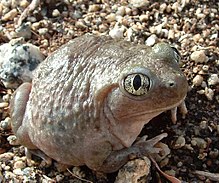Spea hammondii
| Spea hammondii | |
|---|---|
 |
|
| Scientific classification | |
| Kingdom: | Animalia |
| Phylum: | Chordata |
| Class: | Amphibia |
| Order: | Anura |
| Family: | Scaphiopodidae |
| Genus: | Spea |
| Species: | S. hammondii |
| Binomial name | |
|
Spea hammondii (Baird, 1859) |
|
| Synonyms | |
Scaphiopus hammondii Baird, 1859
Spea hammondii Cope, 1866
The western spadefoot toad (Spea hammondii) is a relatively smooth-skinned species of American spadefoot toad. Its eyes are pale gold with vertical pupils. It has a green or grey dorsum often with skin tubercles tipped in orange, and it is a whitish color on the ventrum. It has a wedge-shaped black spade on each hind foot. Adult toads are between 3.8 and 7.5 cm (1.5 and 3.0 in) long.
Juvenile western spadefoot toads look similar to adults, but have more distinct spotting.
Populations of Spea hammondii are localized, but widespread. It ranges throughout the central valley of California as well as the coast south of San Jose and some parts of the desert. The western spadefoot prefers grassland, scrub and chaparral locally but can occur in oak woodlands. It is nocturnal, and activity is limited to the wet season, summer storms, or during evenings with elevated substrate moisture levels. It is easily handled, with less skin secretions than similar toad species. Their secretions smell like peanut butter and may cause sneezing. The western spadefoot is experiencing some habitat loss, but is still common in its range and the population declines are very minor even though it is listed as "near threatened" in some counties of CA.
Tadpoles feed mainly on plants and planktonic organisms, algae, ants, small invertebrates and dead aquatic larvae of amphibians, they may become cannibalistic. Adult toads feed on insects, worms and other invertebrates including; grasshoppers, true bugs, moths, ground beetles, ladybird beetles, click beetles, spiders, flies, ants and earthworms.
The average life span for the Western Spadefoot Toad is about 12 years. They reach sexual maturity in their third year. The female spadefoot toad will lay up to 2,000 eggs (per season?). The cordon of eggs attaches to objects in the water or puddles or ditches and the male deposits sperm on them. Tadpoles emerge in as little as 15 hours. After hatching, the tadpole's only chance for survival is to develop into a toad before the puddle dries up, which takes 12 to 13 days. This is the fastest metamorphosis known for any frog or toad. Reproduction: the breeding of laying eggs normally occur from late winter to the end of March. Males will be heard during this period. Females lay numerous small, irregular clusters that will contain from 10 up to 42 eggs. They may lay more than 500 eggs in one season. Eggs hatching happens rapidly within two weeks.
...
Wikipedia

